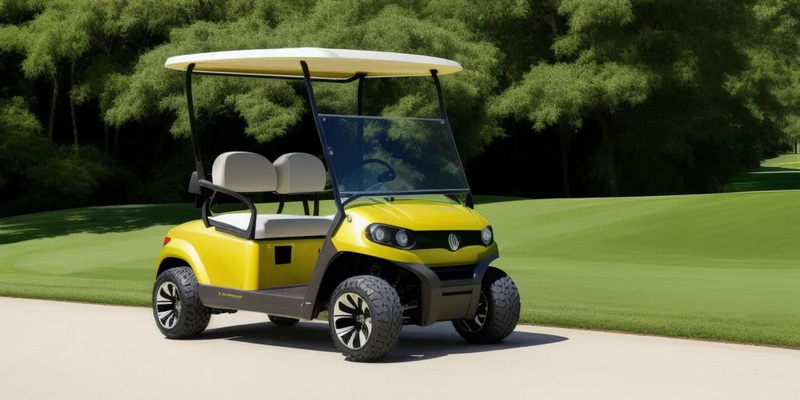Content Menu
● Understanding Electric Golf Cart Range
>> Battery Types
>> Weight and Load
>> Terrain and Conditions
>> Driving Habits
● Maximizing Your Electric Golf Cart's Range
>> Regular Maintenance
>> Optimize Battery Charging
>> Reduce Weight
>> Drive Smoothly
>> Plan Your Route
● Real-World Examples of Electric Golf Cart Ranges
>> Golf Course Usage
>> Residential Communities
>> Urban Areas
● The Future of Electric Golf Carts
>> Smart Technology Integration
>> Environmental Impact
● Conclusion
● Frequently Asked Questions
>> 1. How long does it take to charge an electric golf cart?
>> 2. Can electric golf carts be used on public roads?
>> 3. What is the average lifespan of an electric golf cart battery?
>> 4. Are electric golf carts suitable for hilly terrain?
>> 5. What maintenance is required for electric golf carts?
Electric golf carts have become increasingly popular not only on golf courses but also in various other settings, including residential communities, parks, and even urban areas. These vehicles are known for their eco-friendliness, ease of use, and versatility. One of the most common questions among potential users is, "How far can you go on an electric golf cart?" In this article, we will explore the factors that influence the range of electric golf carts, the technology behind them, and practical tips for maximizing their distance.

Understanding Electric Golf Cart Range
The range of an electric golf cart refers to the distance it can travel on a single charge. This distance can vary significantly based on several factors, including the type of battery, the weight of the cart, the terrain, and driving habits.
Battery Types
Electric golf carts typically use one of two types of batteries: lead-acid batteries or lithium-ion batteries.
- Lead-Acid Batteries: These are the traditional battery type used in many electric golf carts. They are generally less expensive but heavier and have a shorter lifespan. A typical lead-acid battery can provide a range of about 20 to 40 miles on a full charge, depending on the conditions.
- Lithium-Ion Batteries: These batteries are becoming more popular due to their lighter weight, longer lifespan, and greater efficiency. A lithium-ion battery can offer a range of 40 to 100 miles or more, making it a better choice for those who need to travel longer distances.
Weight and Load
The weight of the golf cart and the load it carries can significantly impact its range. Heavier carts or those carrying additional passengers or cargo will require more energy to operate, thus reducing the distance they can travel on a single charge.
Terrain and Conditions
The terrain on which the golf cart is driven also plays a crucial role in determining its range. Flat, smooth surfaces allow for greater efficiency, while hilly or rough terrain can drain the battery more quickly. Additionally, driving on grass or uneven surfaces can increase resistance, further reducing the distance traveled.
Driving Habits
Driving habits can also affect the range of an electric golf cart. Aggressive acceleration, frequent stops, and high speeds can all contribute to faster battery depletion. Conversely, smooth acceleration and maintaining a steady speed can help maximize the distance traveled.
Maximizing Your Electric Golf Cart's Range
To get the most out of your electric golf cart, consider the following tips:
Regular Maintenance
Regular maintenance is essential for ensuring your golf cart operates efficiently. This includes checking the battery's water levels (for lead-acid batteries), cleaning the terminals, and ensuring the tires are properly inflated.
Optimize Battery Charging
Proper charging practices can extend the life of your battery and improve its performance. Avoid letting the battery discharge completely before recharging, and try to charge it after each use. If you have a lithium-ion battery, use a smart charger that can optimize the charging process.
Reduce Weight
If possible, minimize the weight of your golf cart by removing unnecessary items. This can help improve efficiency and extend the range.
Drive Smoothly
Adopt smooth driving habits. Avoid rapid acceleration and hard braking, as these can drain the battery more quickly. Instead, accelerate gradually and maintain a steady speed.
Plan Your Route
If you know you will be traveling a long distance, plan your route to avoid steep hills and rough terrain. Stick to flat, paved paths whenever possible.

Real-World Examples of Electric Golf Cart Ranges
Many manufacturers provide specifications for their electric golf carts, including estimated ranges. For instance, some models are designed specifically for longer distances and can achieve ranges of up to 100 miles on a single charge.
Golf Course Usage
On golf courses, electric golf carts are typically used for short distances between holes. Most golf courses are designed to accommodate the average range of electric carts, making them ideal for this purpose. Players can expect to travel between 5 to 10 miles during a round of golf, well within the capabilities of most electric carts.
Residential Communities
In residential communities, electric golf carts are often used for short trips to amenities such as pools, clubhouses, and parks. Many residents find that their carts can easily handle daily errands without needing to recharge frequently.
Urban Areas
In urban settings, electric golf carts are increasingly being used for short commutes and errands. Some cities have even designated lanes for golf carts, allowing for safe travel alongside traditional vehicles. In these scenarios, the range of the cart is often sufficient for daily activities, with many users reporting ranges of 30 to 50 miles on a single charge.
The Future of Electric Golf Carts
As technology continues to advance, the future of electric golf carts looks promising. Manufacturers are investing in research and development to create more efficient batteries, lighter materials, and improved designs. This innovation will likely lead to electric golf carts with even greater ranges and capabilities.
Smart Technology Integration
Many modern electric golf carts are now equipped with smart technology that can enhance the user experience. Features such as GPS navigation, battery management systems, and connectivity with mobile apps allow users to monitor their cart's performance and plan their routes more effectively. This technology can help users maximize their range and ensure they are using their carts efficiently.
Environmental Impact
The shift towards electric golf carts also aligns with broader environmental goals. As more people become aware of the impact of fossil fuels on the environment, the demand for electric vehicles, including golf carts, is likely to increase. This trend not only helps reduce carbon emissions but also promotes a more sustainable lifestyle.
Conclusion
Electric golf carts offer a convenient and eco-friendly mode of transportation for a variety of settings. Understanding the factors that influence their range, such as battery type, weight, terrain, and driving habits, can help users maximize their distance on a single charge. By following best practices for maintenance and operation, electric golf cart owners can enjoy longer rides and greater efficiency.
As electric golf carts continue to evolve, advancements in battery technology and design will likely lead to even greater ranges and capabilities. Whether for leisure on the golf course or practical use in residential and urban areas, electric golf carts are here to stay, providing a sustainable and enjoyable way to travel.

Frequently Asked Questions
1. How long does it take to charge an electric golf cart?
Charging times can vary based on the type of battery and charger used. Generally, lead-acid batteries take about 6 to 8 hours to fully charge, while lithium-ion batteries can charge in 4 to 6 hours.
2. Can electric golf carts be used on public roads?
In many areas, electric golf carts can be used on public roads, provided they meet certain safety requirements and local regulations. It's essential to check your local laws before driving on public streets.
3. What is the average lifespan of an electric golf cart battery?
The lifespan of an electric golf cart battery depends on the type of battery and how well it is maintained. Lead-acid batteries typically last 3 to 5 years, while lithium-ion batteries can last 5 to 10 years or more with proper care.
4. Are electric golf carts suitable for hilly terrain?
Electric golf carts can handle hilly terrain, but their range may be reduced due to the increased energy required to climb hills. It's advisable to choose a cart with a powerful motor and a suitable battery for hilly areas.
5. What maintenance is required for electric golf carts?
Regular maintenance for electric golf carts includes checking battery water levels (for lead-acid batteries), cleaning battery terminals, inspecting tires, and ensuring all electrical components are functioning correctly. Regular servicing can help extend the life of the cart and its components.










































